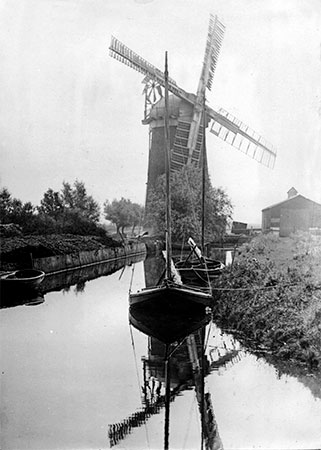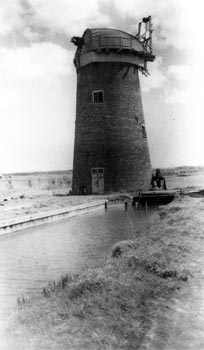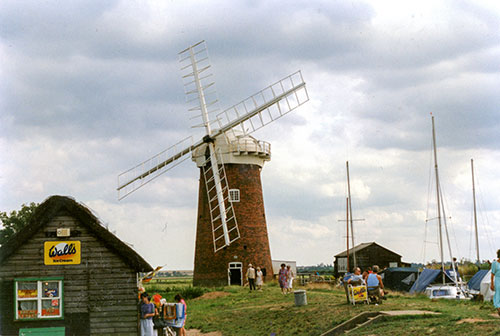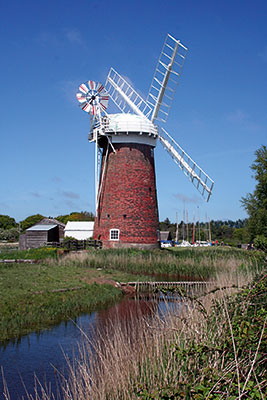
c.1911
Horsey drainage pump Horsey Mere |
 |
c.1911 |
Horsey drainage mill was built in the mid 1800s and rebuilt by millwrights England of Ludham in 1897 as a 4 storey, red brick tower wind pump with a Norfolk boat shaped cap, petticoat, gallery and 4 patent sails to drive a turbine. The mill stood near the road beside a dyke.
|
A steam powered pump was installed to supply power in times of low wind and this was replaced by a diesel powered pump in 1939. The diesel pump worked full time after the lighning strike of 1943 and this was in turn replaced by an electric pump in 1957.
|
 |
c.1930 |
 |
 |
1940 |
c.1951 |
 |
 |
c.1955 |
24th May 1958 |
Of smuggling...
Once contraband had been landed on the Norfolk shore, the Broads provided an elaborate and intricate system of distribution. Barges plying a perfectly legitimate trade were happy to take on board a little extra cargo that provided a higher return than a hold full of coals. The wherrymen who plied the Broads evolved an ingenious semaphore system to warn of the approach of the customs authorities: Smugglers Britain website - see links page If a search was suspected by those on the watch...warning was sent by a runner to the nearest marshman. If his mill was turning he would stop it at the St Andrew's (diagonal) cross, then wait until those at the next mill had seen him and done the same. Then he would let the mill turn again. If there was no wind the boy would be sent up to climb on the sail, and his weight used to turn the mill to the required position...The clear signal would be telegraphed using the St George (square) cross on the mill sail.
Eastern Daily Press - 18th October 1963 Horsey Mill was reputedly used in this way: a message could travel from Yarmouth to Horsey in a quarter of an hour — much faster than a customs man could ride.
National Trust When a wherryman saw the sails stop turning, he would sink his tubs in the broad, marking the spot with a float made of reads. The marshman at the mill would pick up the contraband later, and share in the proceeds. There was a risk attached to this procedure - sometimes the kegs would drift free and be lost. This possibility was avoided by lobbing the tubs into a drainage ditch: the mill gradually pumped the water along the ditch, so that the tubs were delivered directly to the marshman.
Mills were useful for other purposes beside signalling: in communities where no-one ever locked their doors (if the doors had locks at all) mills were among the few places that could be secured without arousing suspicion. Close to Stalham Dyke a mill was used as a storage place in this way: the contraband hidden there came into the country between Horsey and Happisburgh. When space ran out at the mill kegs were sunk in nearby Sutton Broad.
Suffling - History and legends of the Broad District |
 |
c.1960 |
The mill was restored in 1961 by the Norfolk Windmills Trust and SPAB but lost its fantail once again in the October 1987 hurricane.
|
 |
May 1971 |
| During restoration, the mill was given new sails without shutters or a spider. The white painted fantail had red striped blades and tailpole. The complete wind powered gearing remained in situ along with the turbine pump in the adjacent pumphouse. |
 |
1989 |
 |
 |
26th January 2004 |
10th September 2006 |
 |
 |
18th November 2012 |
7th June 2013 |
Landmark Norfolk mill gains new sails in major restoration project |
Easy does it! A mill on the Norfolk Broads has been fitted with new sails as part of a National Trust restoration project. The four old sails, which were "pretty" but did not turn, were removed from Horsey Windpump in 2014 after they became rotten. Alex Green, National Trust spokeswoman, said she hoped the newly-constructed replacement sails would be be turning by summer. This would be the first time they have turned in 75 years, following a severe lightning strike in 1943 which split the timber stocks that held the sails together. A timber shortage at the time meant they remained damaged and pumping was carried out by a diesel motor in the following years. The new sails were raised into place using a lorry with lifting gear instead of a crane, due to soft ground, with the millwright on a cherry picker to attach them. Three sails were in place as light faded on Friday, with the fourth expected to be fixed in place under floodlights. The purpose of the drainage windpump is to pump water from dykes, which drain the land, out into the Broads and tidal waterways. Its job is now done by an electric pump, and the mill is being restored so the public can see demonstrations of how it used to work. A new cap was fitted to the top of the mill's brick tower, which was built in 1912, last year and the fitting of the new sails marks the end of phase one of the restoration project. Ms Green said the next stage was to fit striking gear and shutters to better control the speed of the sails, and the final phase will be to restore the turbine so the drainage mill can pump water. "That's the ultimate ambition," she said. "To have the mill here as a fully working windpump." She said this is expected to be completed in the next few years. Anthony Carroll, Great Yarmouth Mercury - 24th February 2018 - also Belfast Telegraph |
 |
28th January 2023 |
 |
 |
7th September 2024 |
|
 |
Horsey drainge pump internal layout drawn by John Brandrick Larger drawing |
 |
|
O. S. Map 1884 Courtesy of NLS map images |
| c.1850: Mill built 1897: Mill rebuilt 1912: Mill rebuilt 1938: Floods surround the mill 1938: Diesel pump installed for auxiliary power 1943: Mill ceased operation after being struck by lightning 1948: Mill ownership taken over by the National Trust 15th April 1955: Mill given a Grade ll listing 1957: Electric pump installed 1961: Restored by Norfolk Windmills Trust and SPAB October 1987: Fantail destroyed in gale 1989: Mill in good condition 2004: Mill recorded as fully restored 30th April 2014: Fixed sails removed after the wood became too rotten for safety February 2018: New sails fitted that should be capable of turning by the summer September 2024: Cap, sails with shutters and fantail all in situ |
If you have any memories, anecdotes or photos please let us know and we may be able to use them to update the site. By all means telephone 07836 675369 or
|
| Nat Grid Ref TG 45732215 | Copyright © Jonathan Neville 2006 |